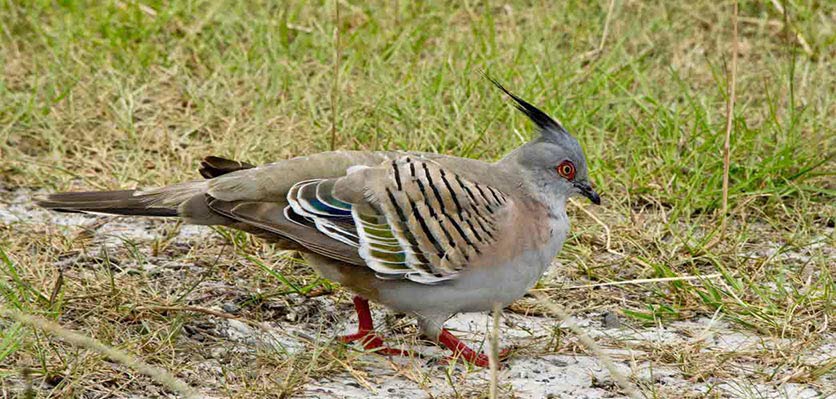
In a wonderful example of evolutionary adaptation, a change in the shape of a single feather on the wing of the crested pigeon (Ochyphaps lophotes) has allowed this species to signal danger through sound.
Birds use non-vocal communication such as plumage colour and size, as well as feather sounds, as a way of visually and audibly communicating sexual fitness to prospective partners. Think of a male peacock flaunting its tail feathers or the mesmerising sway of a bird of paradise.
Now a team from the Australian National University have described wing flapping sound as a non-vocal communication signal in crested pigeons.1 The wing flap speed, and subsequent frequency and tone of the resulting sound, of these birds at routine take-off is different from that during an escape, leading researchers to believe that the sound acts as a warning signal to surrounding pigeons.
The researchers set out to establish if the wing flap sound at escape was a non-vocal signal and not just a cue (i.e. a side effect of movement). To do this, they needed to demonstrate three criteria:
- That the action was a form of communication.
- That it was the result of an evolved action or feature.
- That it elicited a specific response to the benefit of both the signaller and the recipient (Table 1).
The team demonstrated that the instrumental sound made by the wing flapping during escape was a form of communication because it had an effect on the behaviour of the receivers. They did this by playing back recorded audio of birds during routine take-off and escape and found that the sound of escape caused birds to flee, where-as that of routine take-off did not.
So the team was successful in showing that the sound produced by wing flapping at escape was either a signal or a cue to other birds.
Next, they needed to show that the sound production at escape was an evolved adaptation. Looking at the shape of the primary and that primary feather 8 (P8) has a unique shape when compared with eight other closely related pigeon species, and differs from adjacent primary feathers. Could the P8 feather have evolved to deliver a specific sound frequency during an escape, acting as an audio warning prompting other birds to flee?
To answer this question, researchers removed P7, P8 or P9 from ded the sound produced at take-off. They found eons without the P8 feather failed to generate the note produced at take-off. Removing P7 and P9 abnormal wing flap tones but in the lower notes. ack to pigeons, the sounds produced by birds with rs were significantly more likely to elicit a reaction when the P8 was absent.
So, the wing flap warning signal definitely benefits recipients. But what's in it for the sender? The authors postulate that the wing-flap warning alerts mates and relatives to danger, thereby conserving lineage. Additionally, it could encourage the entire flock to flee at once, confusing any approaching predators.
During the escape, wings flap faster than during routine take-off and flap tone frequency is higher – so wing tone is intrinsically coupled to flap speed, making this a reliable signal during the escape. Therefore, wing flapping is a signal and not just a cue, thanks to the specialised, highly modified 8th primary wing feather of the crested pigeon.
Reference
Murray TG, Zeil J, Magrath RD. Sounds of modified flight feathers reliably signal danger in a pigeon. Curr Biol 2017;27:3520–3525.
Table 1. Definition of communication, signal, and cue in an evolutionary context
This article appeared in the January/February 2018 issue of the Australian Veterinary Journal

